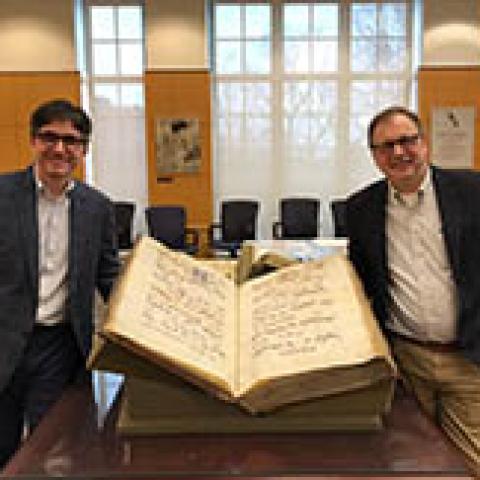When David Rothenberg, PhD, professor and chair of Case Western Reserve University’s Department of Music, teaches classes about early music history he often relies on digital resources and replicas of old music books. But a recent acquisition by Kelvin Smith Library’s Special Collections created the opportunity for some of his students to experience singing Gregorian chants from a massive 500-year-old gradual—a book used by priests and clergy centuries ago in Spain.
“Gregorian chant was the repertoire where music notation as we know it came into being, “ said Rothenberg. “That’s a neat story to tell, and as you tell that story it’s nice to have an old book to show to people firsthand what the notation looks like.”
The book is impressive, even before opening it—measuring 25 inches long, 18 inches wide and six inches deep.
“I saw the dealer listing for the choir book in December and conferred with David Rothenberg about its value for our collection,” said Bill Claspy, Kelvin Smith Library team leader for special collections and university archives. “It was shipped to us in February, arriving in an enormous wooden crate (see photo)”
Rothenberg says he can teach music majors the rules of reading older notation in 10 minutes, noting the older music shares similarities with modern notation such as using a staff and clefs.
“The most common clef in older notation is the C Clef,” said Rothenberg. “It means it is on the line for C so that’s how you orient yourself.”
Rothenberg says there are differences in the types of notation as well.
“It has a bunch of shapes, most of them square. There’s no rhythm in Gregorian chant so you don’t have to worry about eighth notes and quarter notes,” said Rothenberg. “There are sometimes two squares right on top of each other—the rule is the lower one comes first—so it’s just a series of two notes. You sing the lower one then the upper one and then you move on to the right.”
Rothenberg shared the book with a doctorate-level musicology class shortly after its arrival on campus. He said the seasoned group of musicians doesn’t impress easily, but the multi-sensory experience of singing from it proved to be very powerful.
“It’s the best type of experiential learning,” said Rothenberg. “It’s really magical. They were touching and looking at the book and smelling the animal hide. It’s a communion with the past.”
Rothenberg plans to use the book in the fall as part of his master-level course in Renaissance music.



